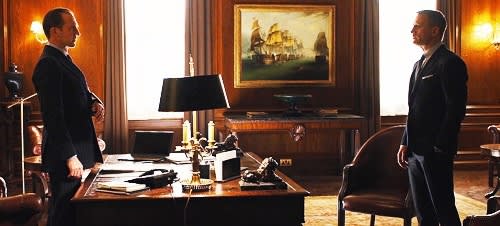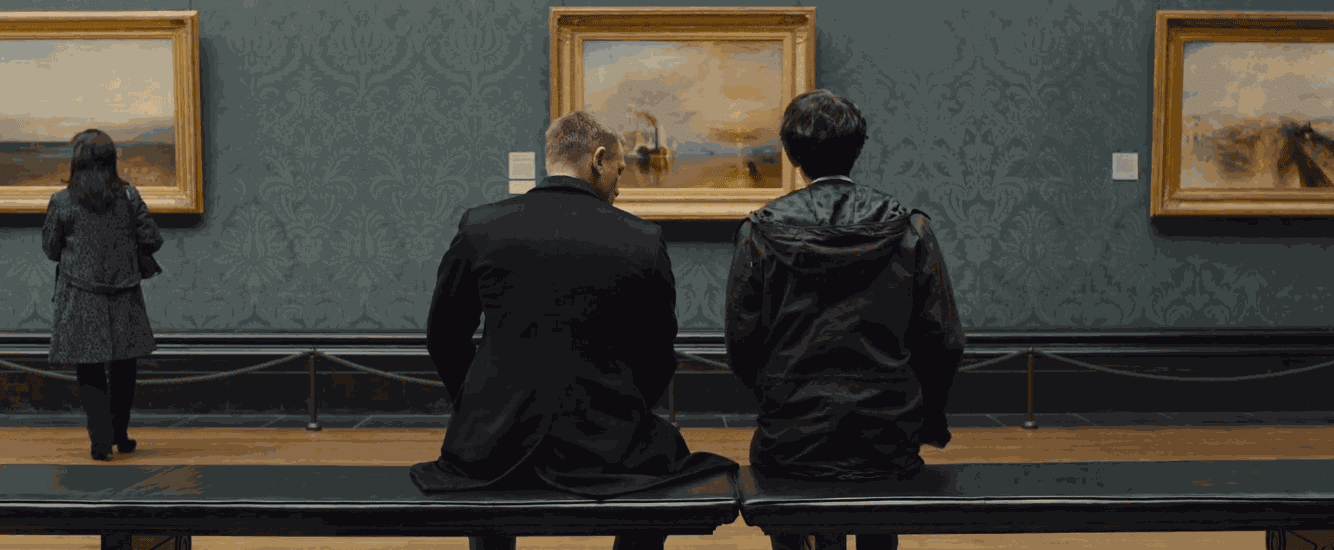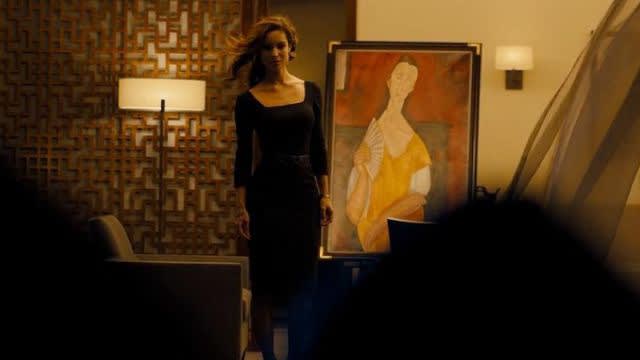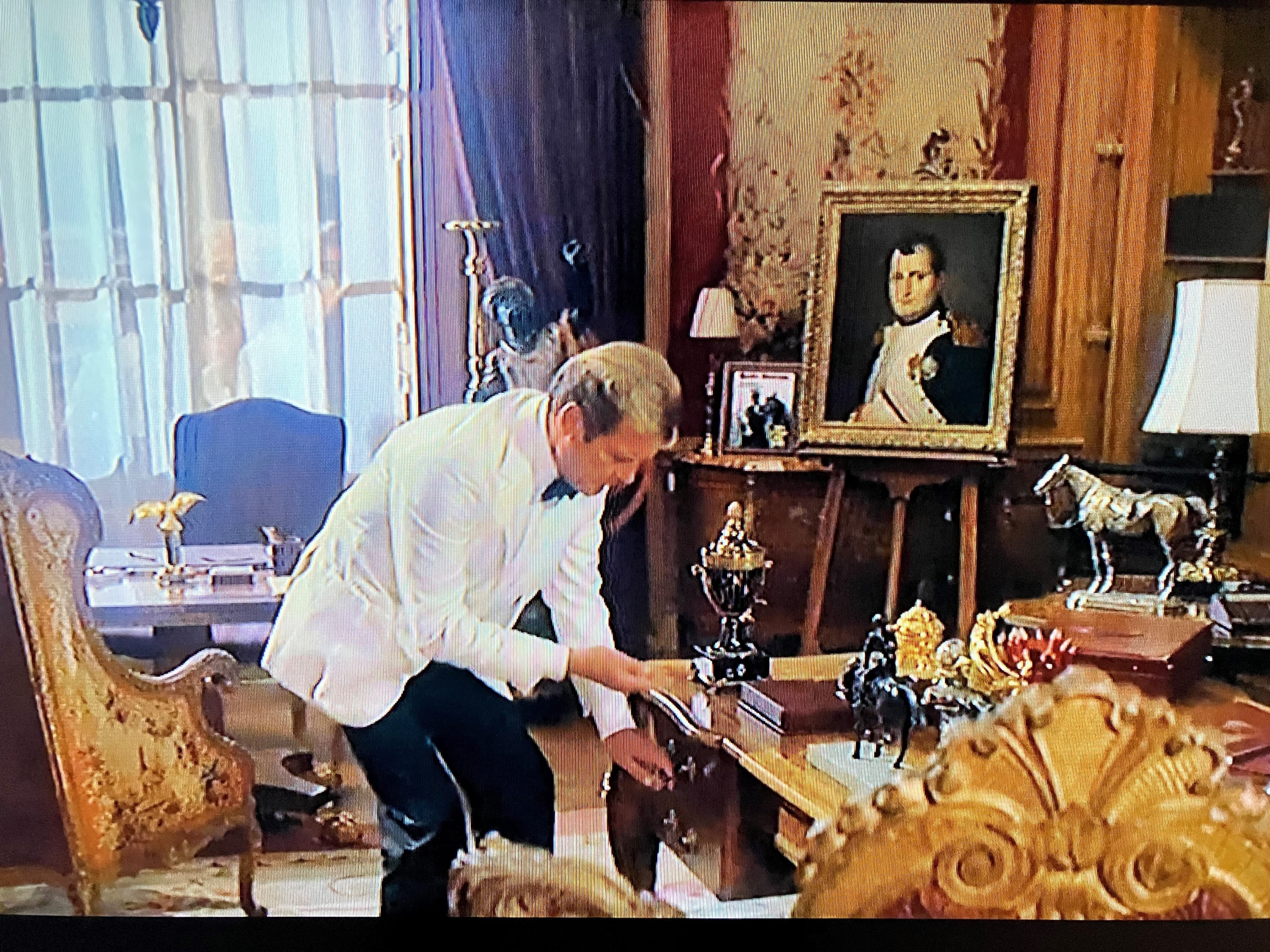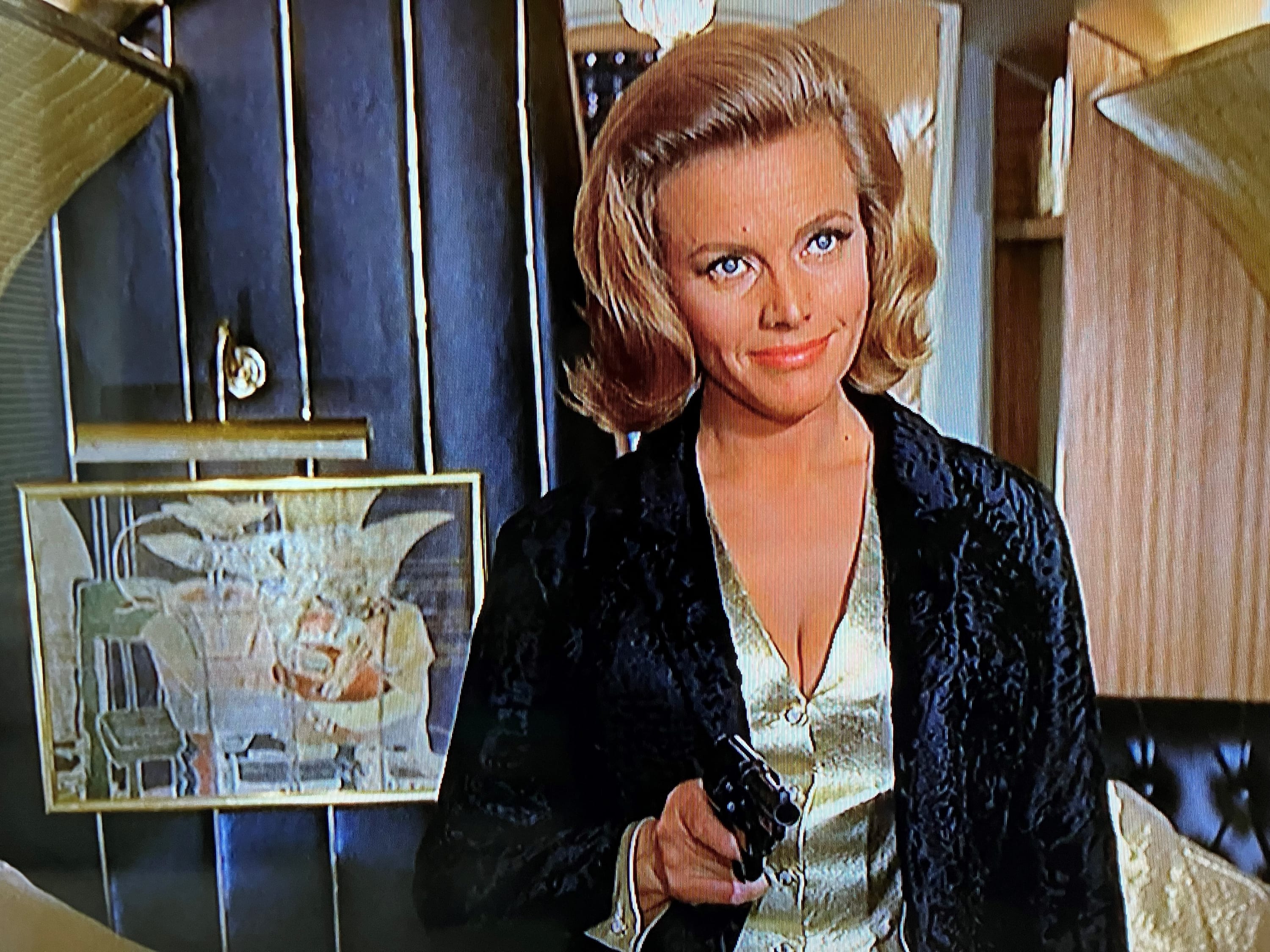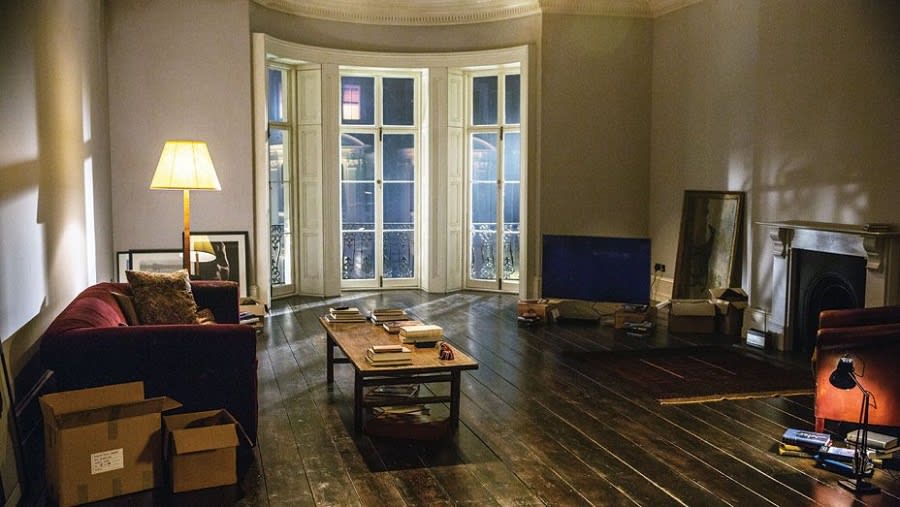-
A history of art in James Bond -
Perhaps I am not alone as someone with an interest in art, who finds themself distracted when watching a film, scanning the background of a scene, trying to identify paintings on the walls. Sometimes art is present for pure decoration but on other occasions it has been carefully chosen to add an extra layer. Fine art is probably not something typically associated with the James Bond films. It is easier to think of exotic locations, gadgets, glamorous women, villains and vodka martinis. But art plays a bigger role than it might seem, and this piece explores some rather fun and subtle placements of art in the series. It should be said from the outset that in most cases a copy of the original artwork is most likely used!
M for maritime? It seems appropriate to begin with a genre of particular interest to Rountree Tryon – maritime art. A prominent feature throughout the series are meetings between Bond and his superior, head of intelligence, ‘M’, in M’s office. In the early films, M was played by Bernard Lee and seasoned fans can probably picture him sitting behind a partner’s desk, pipe in hand, in a wood-panelled room with a leather-padded door. Decorating the office are maritime objects such as telescopes and ship models, and on the walls, maritime paintings of naval engagements and ship portraits, which appear to date from the Napoleonic era. These items are not directly referenced but have been placed to acknowledge Ian Fleming’s original portrayal of M as a former Vice Admiral. In this way the works are no different to the art on our own walls, which often reflect our interests and experiences. Their inclusion helps bring the character from the books to life and support M’s presentation on screen as a serious and patriotic authority figure, who would likely have traditional taste. It is fun to imagine these items might have been passed down from naval ancestors or chosen by M from the Government Art Collection. Within the films, these images of the Royal Navy’s golden age also serve to inspire M and Bond (a former Commander in the Navy) in their mission to defeat the next threat for Queen and country.
-

-
 Maritime paintings in M’s office in Dr No (1962) and On Her Majesty’s Secret Service (1969)
Maritime paintings in M’s office in Dr No (1962) and On Her Majesty’s Secret Service (1969) -
The films largely continue to portray M in this way until a change in direction, both in character and office interior, when Judi Dench takes up the role in Goldeneye (1995). However, an office closer to the mould of the Bernard Lee M is nostalgically revived in a scene at the end of Skyfall (2012), when Gareth Mallory is introduced as the new head of MI6. Identifiable in the room is a painting of perhaps Britain’s greatest naval victory - The Battle of Trafalgar in 1805. The artist is Thomas Buttersworth (1768-1842), a well-known maritime painter from the Napoleonic period who was in the navy before being invalided. He produced a number of paintings of Trafalgar during his career, including one he exhibited at British Institute in 1825 and was sold at Bonhams in 2003 for £62,000 (hammer).
-

-
 Paintings in Skyfall (2012): Top - Thomas Buttersworth’s Battle of Trafalgar. Bottom - J M W Turner’s The Fighting Temeraire, tugged to her last berth to be broken up
Paintings in Skyfall (2012): Top - Thomas Buttersworth’s Battle of Trafalgar. Bottom - J M W Turner’s The Fighting Temeraire, tugged to her last berth to be broken up -
The Buttersworth painting doesn’t just hark back to M’s office of the early films, it is also relevant in the context of Skyfall, in relation to a previous scene when Bond meets his new Quartermaster ‘Q’ (Ben Wishaw) in the National Gallery. Q joins Bond sitting in contemplation before one of Britain’s most celebrated maritime paintings, The Fighting Temeraire, tugged to her last berth to be broken up by JMW Turner (1775-1851). The painting depicts the warship HMS Temeraire, which had played a key role at The Battle of Trafalgar, being towed up the Thames to be scrapped as the sun sets beyond. Painted in 1838, the work symbolises the end of an era and advancements of the industrial age, as a much smaller steamship tows the now redundant war hero on her final journey. In a rather humorous and tense exchange, the new Q says the painting
…always makes me feel a little melancholy. A grand old warship being ignominiously hauled away for scrap. The inevitability of time, don’t you think? What do you see?
Bond simply replies – A bloody big ship.
In a not-so-subtle way, Q is suggesting that the Temeraire is representative of Bond’s own position within MI6. A running theme of the film is whether middle-aged Bond is, like the Temeraire, outdated and surplus to requirements. And his younger colleague, who might be said to reflect the steamship in the painting, taunts Bond further –
I can do more damage on my laptop sitting in my pyjamas before my first cup of Earl Grey than you can do in a year in the field.
Q is absolutely right to point out the modern-day threat of cyberwarfare but equally brave to question Bond’s ability, who inevitably proves the doubters wrong and saves the day. Thus, the use of the Trafalgar painting , depicting Temeraire’s greatest moment, in Mallory’s office at the end of Skyfall, might be said to signify a return to the Bond of old and that he is not quite finished yet.
Continuing the Napoleonic theme, a half-length portrait of Arthur Wellesley, 1st Duke of Wellington in full dress uniform by Spanish painter Francisco de Goya (1746-1828) features in Dr No (1962). The painting is prominently displayed on an easel during a scene in the villain’s lair, causing Bond to pause and double take as he passes it. Most people would need to be over a certain age to be aware of this significance, as the painting had been in the public eye after it was stolen from the National Gallery in August 1961, only 19 days after being acquired from Sotheby’s and its whereabouts was still a mystery at the time of the film. It is a rather fun reference, successfully blending real life and fiction, leading us to believe it was Dr No who was behind the theft. And quite conceivably – a cultured criminal mastermind with the resources to arrange such a heist, who would want an image of a great military tactician to represent his perceived power and inspire his villainous ambitions. It has even been suggested that the idea of artworks being ‘stolen to order’ originated here. Ironically, the actual thief (with the help of his son) was not a megalomaniac villain but a retired bus driver from Newcastle, Kempton Bunton and the 2020 film The Duke starring Jim Broadbent tells the story about the theft. The painting was recovered and still hangs in the National Gallery today. It is one of three works by Goya of the Duke which are thought to have been based on sittings in Madrid following the Duke’s victory at the Battle of Salamanca in July 1812.
-

-
 Stolen paintings: Goya’s portrait of The Duke of Wellington in Dr No (1962) and Modigliani’s Woman with a fan in Skyfall (2012)
Stolen paintings: Goya’s portrait of The Duke of Wellington in Dr No (1962) and Modigliani’s Woman with a fan in Skyfall (2012) -
In what is perhaps a homage to Dr No, the theme of a real-life stolen masterpiece is subtly used again in Skyfall. Yet another painting to be spotted in the film is Woman with a fan by Italian expressionist Amedeo Modigliani (1884-1920), which is used to lure in a prospective buyer who is then assassinated during a scene in Shanghai. The portrait, a fine example of the artist’s distinctive elongated style, was painted in 1919, a year before Modigliani died and is one of ten he painted of his model Lunia Czechowska. It was stolen from the Museum of Modern Art in Paris in 2010, together with works by Henri Matisse, Georges Braque, Pablo Picasso and Fernand Leger which were estimated to have combined value of around 100m euros. The painting reappears in the sequel Spectre (2015), on the wall of a guest bedroom at villain Ernst Stavro Blofeld’s Moroccan crater base. This effectively reveals Blofeld as the ‘owner’ and is a reminder of his affiliation with villain Raoul Silva, a close ally of Blofeld’s criminal organisation SPECTRE, who was behind the use of the painting in Skyfall. The painting is a symbol of SPECTRE’s power, demonstrating that their criminal activity extends to the theft of highly valuable artworks.
There are other villains with a taste for art – Max Zorin in A View to a Kill (1985) rather fittingly (for its subject and location) has a painting of Napoleon Bonaparte on display in his study at his French chateau. The head and shoulders portrait by Napoleon’s ‘premier peintre’ Jacques-Louis David (French, 1748-1825) appears to relate to the artist’s full length 1812 work The Emperor in His Study at the Tuileries, now in the National Gallery of Art in Washington. As in the full-length, the painting seen in the film depicts the French emperor in Imperial Guard uniform. Painted when France was under the threat of British and Prussian invasion, David captures Napoleon ready to defend his nation and sought to bring about patriotism. Napoleon is shown with his hand in his waistcoat, a motif David used in several works to illustrate the leader’s calm and controlled leadership. Similarly to Dr No’s Goya, the painting of the great military leader is a symbol of Zorin’s hubris but like Napoleon, Zorin’s conquest ends in defeat.
A rather different statement and one of pure luxury and style, is Auric Goldfinger, who has a painting by cubist Georges Braque (French 1882-1963) on his private jet in Goldfinger (1964). A rather fun (and quite random!) selection by the set designers, Grand intérieur à la palette was painted relatively late in the artist’s career in 1942 and today is found in The Menil Collection in Houston, Texas.
-

-
 Villains’ paintings. Jacques-Louis David’s portrait of Napoleon in Zorin’s study in A View to a Kill (1985) and Georges Braque’s Grand intérieur à la palette on Goldfinger’s private jet in Goldfinger (1964).
Villains’ paintings. Jacques-Louis David’s portrait of Napoleon in Zorin’s study in A View to a Kill (1985) and Georges Braque’s Grand intérieur à la palette on Goldfinger’s private jet in Goldfinger (1964). -
What about Bond’s taste in art? A rare scene inside his London flat takes place in Spectre (2015) and shows a sparsely decorated living room with unpacked boxes, piles of books and pictures yet to be hung, indicating he spends little time there – not hard to imagine! The furniture and lighting are traditional but most intriguingly there is a period equestrian painting of a bay horse in a landscape leaning against the wall, revealing an interest in sporting art. Could this be this by the great George Stubbs?! Sadly that is not known but the painting is perhaps a comforting reminder of the owner’s upbringing in rural Scotland at his family home Skyfall. He is of course a fine horseman, demonstrated in various moments in the series! The same painting also appears on the wall in the casino at Les Ambassadeurs Club in Dr No (1962) and in Bond’s garage in No time to die (2021).
-
 Portrait of horse leaning against the wall in Bond’s London flat – Spectre (2015)
Portrait of horse leaning against the wall in Bond’s London flat – Spectre (2015) -
 Portrait of King William III at the Battle of the Boyne in 1690 punctured with Bond’s dart in M’s office – Moonraker (1979)
Portrait of King William III at the Battle of the Boyne in 1690 punctured with Bond’s dart in M’s office – Moonraker (1979) -
Continuing with the genre of equestrian art, a final example features in an amusing scene in M’s office in Moonraker (1979). A portrait of King William III at the Battle of the Boyne in 1690, thought to be by baroque Dutch artist Jan Wyck (1640-1702), is accidently punctured with a dart by Bond as he tests out a new gadget from Q. One hopes the government have a good restorer who can discreetly repair the damage! Wyck completed many commissions for William III, often in equestrian poses and is considered a key contributor to the development of equine and sporting painting in Britain. Renowned eighteenth-century sporting artist John Wootton (c.1682-1764) was a pupil.
In all these examples, knowledge of the works is of course not essential to following the films, but their inclusion shows how art can be used to enrich our viewing experience, adding depth and intrigue to characters and storylines. They are also a reminder of the wonderful breadth and diversity of art - the works discussed here span multiple genres and periods. So, it is certainly worthwhile paying close attention to the background of a scene next time you are watching something, but keep concentrating on the plot…
Rowland Rhodes


